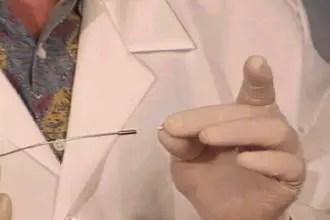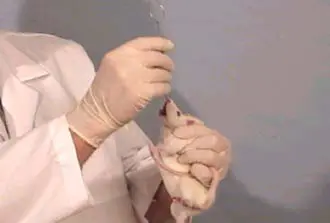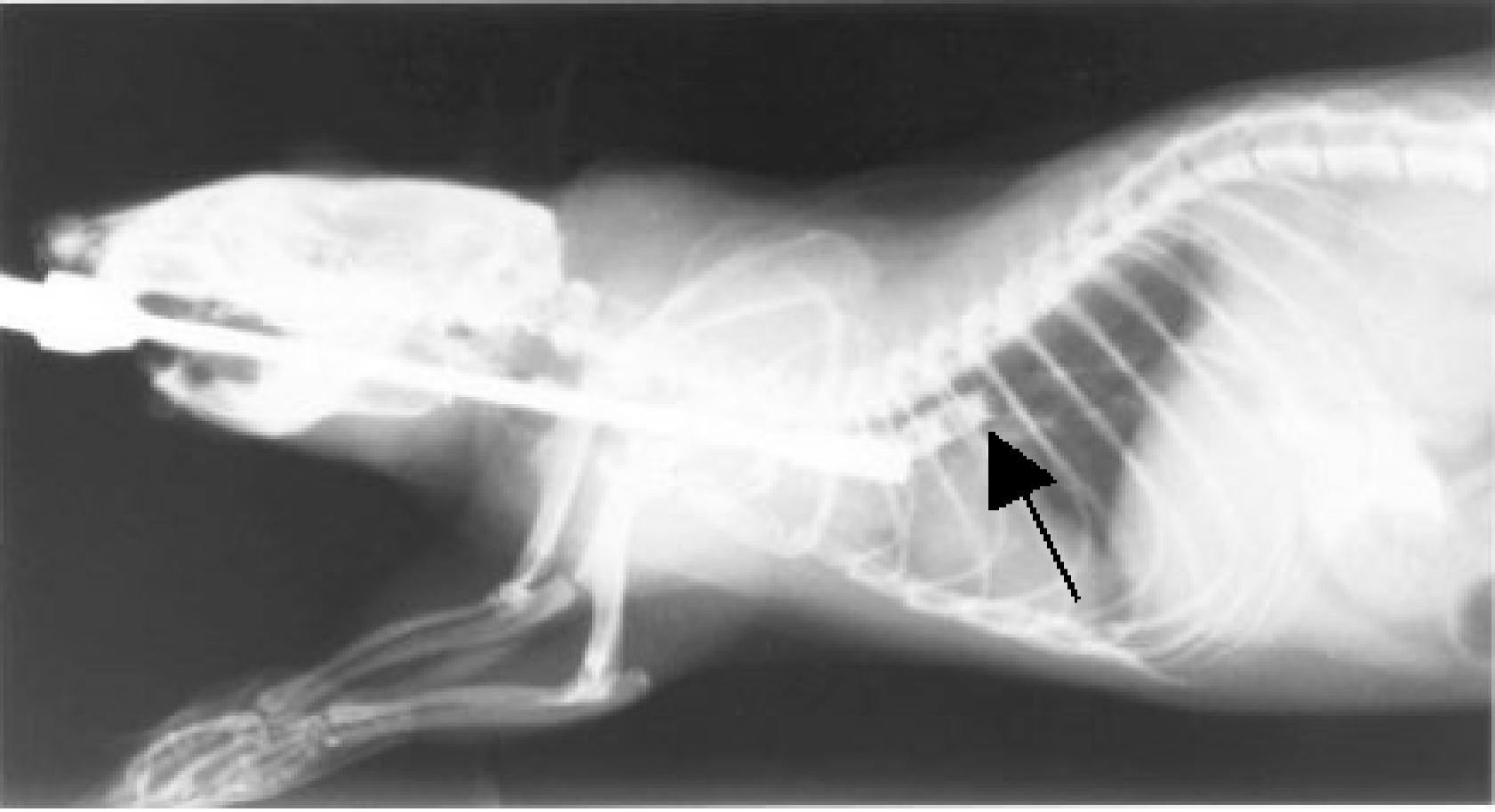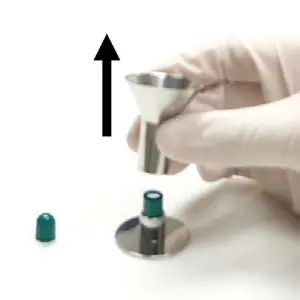

9el 9 9h M

Dosing Kits include capsules, funnel, stand, tamper, dosing device &instructional video
• Ideal for materials that are insoluble, form poor suspensions, are affected by excipients or are odorous and distasteful, e.g., sustained release beads, paint flakes, chromic oxide marker
• For capsule size, species, weight, and lower GI drug delivery size see table below. Capsule holders available for dip coating in enteric solutions. Capsule sinkers available for testing in disintegration test apparatus.
• Size 9 can be used for intra-colonic delivery via rectal insertion in rats >200-250g.
• Save time and money by eliminating validation of suspension / solution homogeneity.
• Eliminate excipients absorption affects.
Fill Materials:
Dry materials in any form(powder, beads, crystals,paint flakes), pastes, and
non-aqueous liquids.
Disintegration Time:
Within 10 minutes in stomach.
Lower GI Drug Delivery:
See below.
Dosing Time & Acceptance:
< 1 min. (30 - 45 minutes for 60 rats).
> 98% successful dosing after minimal experience (3 - 4 placebo doses per rat).

Lock Ring
prevents
accidental
spillage*
*Size 9el, 9, 9h

Capsule Dosing the Rat
Dr. Eric Weyand, Research Scientist
Maple City Research, Hornell, NY, USA
Torpac’s size 9 empty gelatin capsules provide a convenient method for orally dosing laboratory rats 200 gm+ (150 gm minimum) using a dosing syringe. Dosing with capsules is an excellent alternative when you cannot
gavage.
Before beginning your study become comfortable dosing a rat. First practice dosing using a gavage needle. Next, practice using empty capsules in the dosing syringe.
Pre-condition the animals by giving 3 doses of saline solution each day for 3 days followed by administering an empty capsule each day for 3 days using the dosing syringe for capsules.
The following instructions include images from the included CD-ROM.

Dosing Size 9 Capsules

1.If you prefer working with a curved dosing syringe, bend the shaft
in a gentle curve (see the video “Dosing Tips” for a demonstration).
In brief, keep the plunger in the shaft and bend all along the length of the
shaft and not just at one point to avoid cracking the shaft.
Before inserting the syringe put it next to the rat with the capsule holder
section over the stomach area and the syringe near the mouth. Note the
length of syringe that extends beyond the mouth. During Step 6 this should
be the position of the syringe when the capsule is ejected.

2.Insert the filled capsule, body (longer and narrower piece) first, into the syringe’s capsule holding cup. A small portion of the capsule’s cap dome will protrude from the cup.
Lubricate the tip of the capsule and the syringe with Vaseline or Glycerin. This makes administration easier and protects the capsule from premature
softening by saliva during administration. This also prevents any loose capsules from prematurely falling out of the syringe.

3.As shown in the video, restrain the rat by grasping the scruff of the neck with one hand and the rear with the other hand.

4.Wrap the rat’s tail around your small finger to secure the lower portion of the rat.

5.Place the tip of the syringe in the center of the mouth and follow the roof of the mouth to the opening of the esophagus. When you feel resistance go slowly until the rat swallows the capsule holder section (the widest part). Tilt the rat's head back with the shaft of the syringe. This straightens the esophagus and makes insertion of the syringe easier.
NOTE: Once the syringe has passed the back of the mouth, if you feel any‘ridges’ you may have entered the trachea. If this happens, slowly remove the syringe. Do NOT eject the capsule.

6.The time from initial insertion to swallowing of the syringe should take
15-20 seconds. If excess time is taken the capsule may soften due to contact with saliva.
Once the rat swallows the capsule holder continue at normal speed moving the syringe down the esophagus with gentle pressure. For a 200-250gm rat 10 cm of the syringe should be inserted past the incisor teeth. Adjust the insertion depth based on the rat’s size.
NOTE: Do not force the syringe.

7.The radiograph above shows the correct placement of the syringe and ejection of a barium filled capsule into the bottom of the esophagus (the black arrow is pointing to the capsule).

8.Now eject the capsule by pushing the syringe’s plunger.
Remove the syringe from the stomach but slow down when the capsule holder section is being withdrawn through the esophagus and mouth.
If there is a concern that the capsule was ejected in the esophagus and not
in the stomach, close the rat's mouth and gently stroke the neck to facilitate
swallowing. A gavage of a few ml of saline solution or water will facilitate movement of the capsule into the stomach.

9.Tips:
a. When dosing additional rats with the same syringe dry the capsule holder section with an absorbent tissue to prevent the next capsule from sticking in the capsule holder.
c. If capsules soften during administration and cannot use Vaseline or Glycerin as suggested in Step 2, consider freezing (or cooling to 5C) prior to administering them.
Capsule Dosing the Guinea Pig
Kathleen Rider, LATG, Veterinary Technology Program
City University of New York, LaGuardia Community College
Torpac’s size 9 empty gelatin capsules provide an easy method of orally dosing guinea pigs 300 gm+ using a dosing syringe. Dosing with capsules is an excellent alternative when you cannot gavage.
Tips on Dosing Capsules with Dosing Syringe
• Before beginning your study, to become comfortable dosing capsules with a dosing syringe, practice dosing using a gavage needle. Next, practice using empty capsules in the dosing syringe.
• If you prefer working with a curved dosing syringe, you can bend the shaft in a gentle curve. In brief, keep the plunger in the shaft and gently bend along the length of the shaft, not just at one point or you may kink the shaft.

1.Insert the filled and locked capsule, body (longer and narrower piece) first, into the opening of the syringe’s capsule holding cup. A small portion of the capsule’s cap dome will protrude from the cup.

2.Restrain the guinea pig by grasping the scruff of the neck. Place the tip of the syringe in the center of the mouth and follow the ridges on the roof of the mouth. Tip the guinea pig’s head back with the shaft of the dosing syringe. Position the dosing syringe at the entry to the esophagus.
The guinea pig does not need to swallow the tip of the syringe.

3.The radiograph shows correct placement of the dosing syringe and a barium filled capsule at the opening of the esophagus (arrow is pointing to the capsule). Now eject the capsule by pushing the dosing syringe plunger.

4.After ejection of the capsule, slowly remove the syringe from the guinea pig’s mouth. Close the guinea pig’s mouth and stroke the neck gently to facilitate swallowing. The capsule will dissolve within 10 minutes in the stomach.
TIP: After dosing the capsule, some researchers dose the guinea pig with a few ml of saline solution or water as they feel this may further facilitate movement of the capsule into the stomach.
Filling Capsules with a Filling Funnel
The Quickest and Easiest Capsule Filling Method For Small Studies

• Ideal for small studies requiring few capsules to be filled.
• Stainless Steel construction maintains high GMP and easy cleanup.
• Fast & Accurate way to fill capsules.
• Lightweight for use on analytical balances
• Available in Size 000-5 including el sizes; for rodents Size M, 9, 9el, and
for veterinary use Size 11 & 12/13.

1.Separate a single capsule. Place the capsule body in the holder. (Longer, narrower part)

2.Place the funnel over the capsule body in the holder.

3.Dose a pre-measured amount of powder into the capsule through the
funnel, or put the assembly on a precision balance, tare it, and dose the
powder into the capsule through the funnel.

4.When the required quantity of powder has been put into the funnel, use the tamper to compress filling material into capsule body.

5.Slowly remove the funnel.

6.Place the capsule’s cap onto the body of the capsule, pressing firmly to lock. Remove the filled capsule from the base.
#9/9el Multi Capsule Filler
Operating Instructions
Ideal for filling multiple capsules at one time when fill weights can be within +/- 7 to 10% of average (e.g. pharmacokinetic studies)


1. Pull gloves tight around fingertips for easier capsule handling.

2. Lift the Capsule Holder using the 2 handles and push both Spacer Plates all the way in and under the capsule holder.

3. Separate capsules one at a time and place caps in a shallow container such as a Petri dish.

4. Place the capsule body (longer, bottom half) into the Capsule Holder with the body opening facing up. Do this for all 40 capsules.

5. When all the holes have capsule bodies in them, pour out a pre-measured quantity of powder. Spread the powder with the Spreader. Push the excess
powder to the Pocket.

6. Use the Tamper to pack powder into capsules. Spread remaining powder as in step 5 for proper fill weight.

7. Slowly pull out the Spacer Plates one at a time. Hold Capsule Holder with both Handles as you pull out each Spacer Plate and then gently let it down.

8. Now the tops of the filled capsule bodies are exposed.

9. Place the top caps of the capsules back onto the bottoms, pressing to fully lock each capsule.

10. After all capsules are joined; turn the entire filler upside-down to remove all filled capsules.